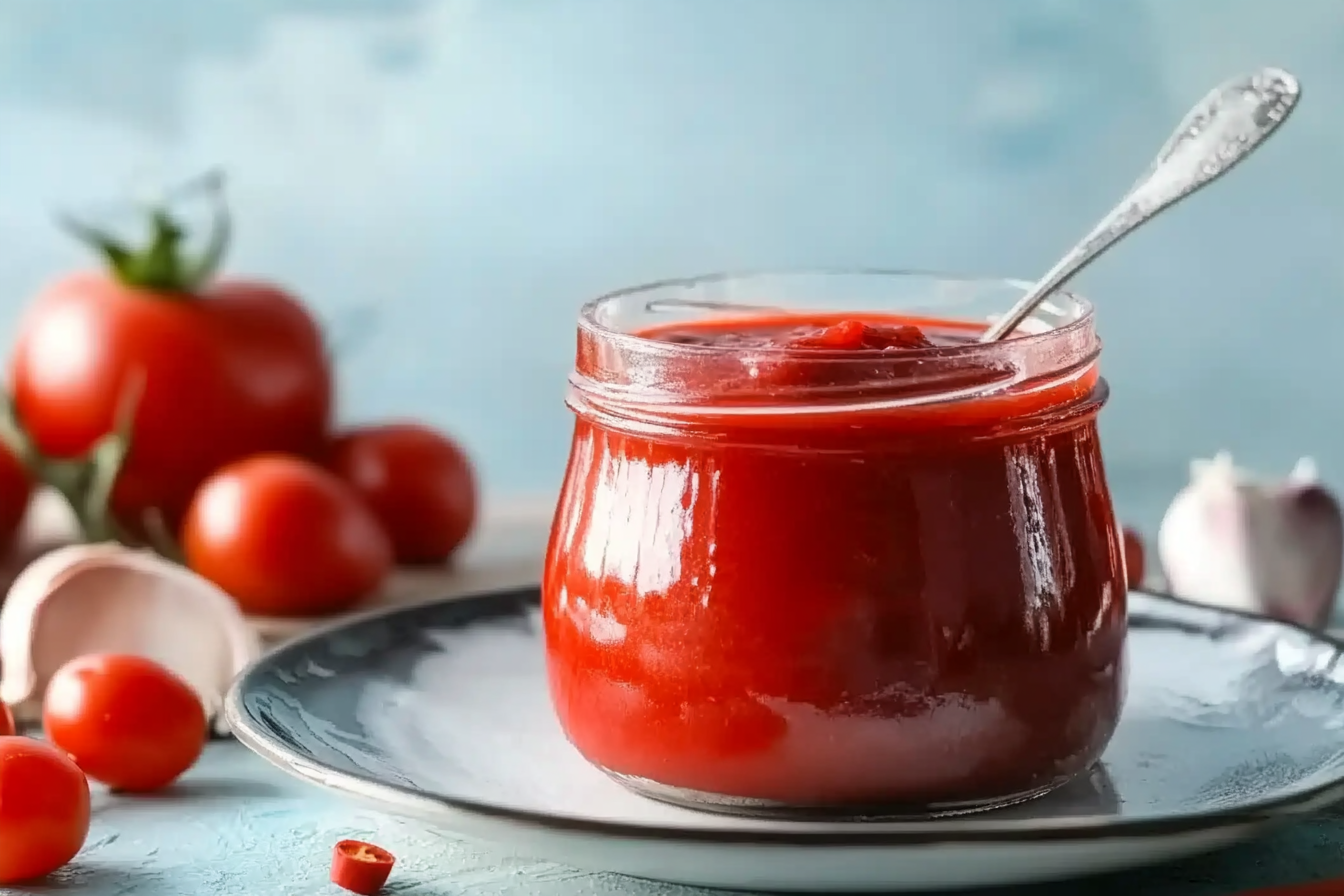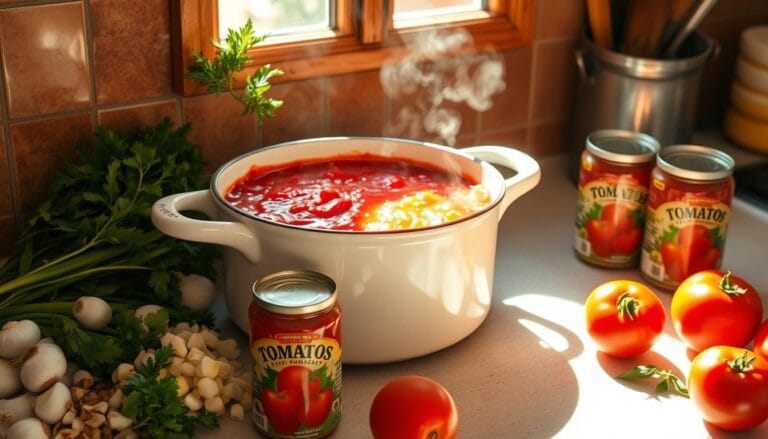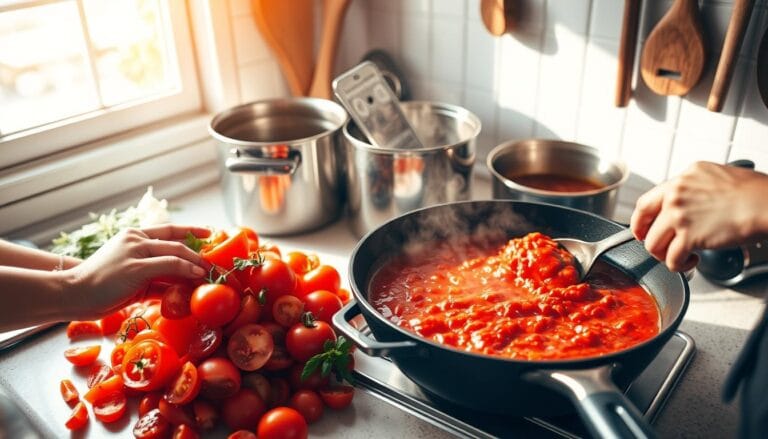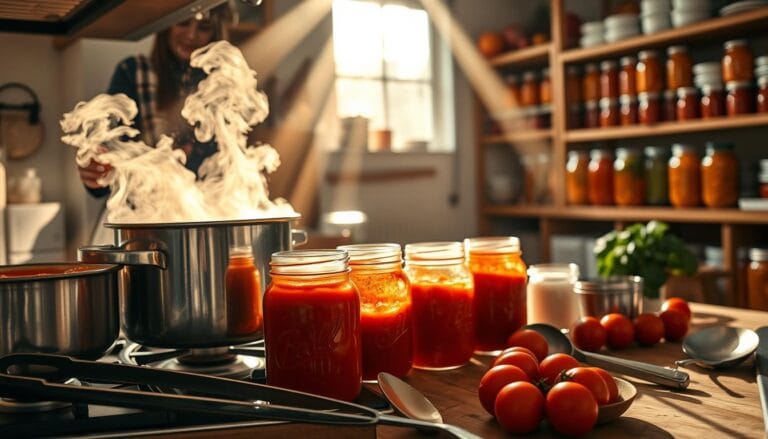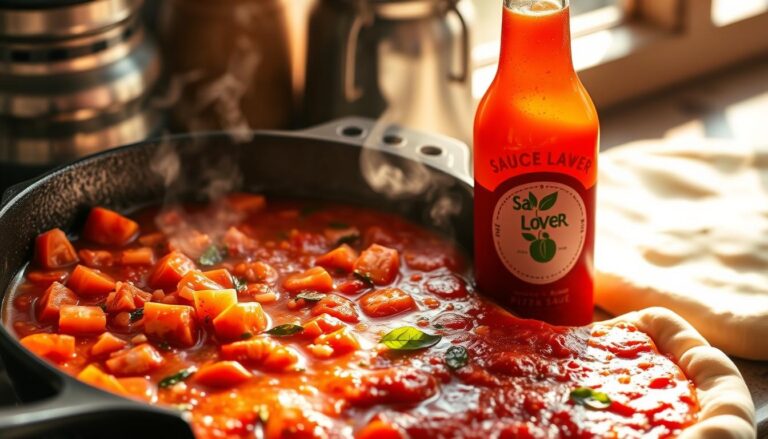Tomato Puree vs Paste: A Comparison Guide
Standing in the grocery aisle, many home cooks wonder about tomato puree vs paste. I recall my grandmother’s kitchen, where she made simple tomato products into rich dishes. These dishes told stories of tradition and flavor.
Knowing the difference between tomato puree and paste can make your cooking better. These tomato products might look similar, but they have unique qualities. They can change your dishes in big ways.
This guide will help you understand tomato puree and paste. We’ll look at how they’re made, their flavors, and when to use them. This way, you can pick the right tomato product for any recipe.
Key Takeaways
- Tomato puree and paste have distinct consistencies and flavor intensities
- Each product serves unique purposes in cooking
- Understanding their differences can improve your cooking techniques
- Both products offer rich tomato flavor with varying concentrations
- Proper selection depends on specific recipe requirements
Understanding Tomato Puree and Paste
Exploring tomato-based ingredients can be tricky. Knowing the differences between tomato sauce, tomato paste, and tomato puree is key to making tasty dishes.
Each tomato product has its own special qualities. Let’s dive into what makes them unique. This will help you pick the right one for your recipes.
What is Tomato Puree?
Tomato puree is a smooth liquid made from cooked and strained tomatoes. It’s known for:
- Being sold in 15 or 28-ounce containers
- Having a thinner consistency than tomato paste
- Being an unseasoned base for many dishes
- Having more water because it cooks for a shorter time
What is Tomato Paste?
Tomato paste is a concentrated tomato product with a strong flavor. It’s special because:
- It’s made in smaller amounts (4-6 ounces)
- It has a thick, paste-like texture
- Only a few tablespoons are needed per recipe
- It’s sold in tubes or small cans for easy storage
“Understanding the nuanced differences between tomato products can elevate your cooking from good to exceptional.” – Culinary Expert
| Characteristic | Tomato Puree | Tomato Paste |
|---|---|---|
| Consistency | Smooth, liquid | Thick, concentrated |
| Typical Package Size | 15-28 ounces | 4-6 ounces |
| Flavor Intensity | Mild, fresh | Rich, concentrated |
| Storage After Opening | 1 week refrigerated | Up to 3 months refrigerated |
Knowing these differences will help you choose the right tomato product for your recipes.
The Production Process of Tomato Puree
Learn how fresh tomatoes turn into a cooking staple. Tomato puree adds richness to your dishes with its smooth texture. It starts with choosing the best tomatoes for your sauce lovers’ kitchen.
How Tomato Puree Comes to Life
Creating tomato puree is a detailed process. It turns fresh tomatoes into a smooth ingredient:
- Select perfectly ripe, high-quality tomatoes
- Wash and prepare the tomatoes for processing
- Blanch tomatoes in boiling water for 2 minutes
- Remove skins and seeds through straining
- Heat and blend to create a smooth consistency

Culinary Magic of Tomato Puree
Tomato puree brings magic to your cooking. It’s versatile and perfect for many dishes. You can use it for:
- Creating rich pasta sauces
- Developing deep pizza bases
- Enriching soups and stews
- Adding depth to casseroles
Pro tip: Tomato puree contains approximately 7-10% solids, making it lighter than tomato paste but packed with flavor!
Remember, tomato puree is more liquid than paste. It’s great for recipes needing a smooth, less intense tomato flavor. Each serving has about 180 calories, offering lots of vitamins A and C.
The Production Process of Tomato Paste
Tomato paste is a concentrated ingredient that adds intense flavor to dishes. It’s made through a detailed process that gives it its unique taste.
Crafting the Perfect Tomato Paste
Making tomato paste requires careful steps. It starts with ripe tomatoes picked within 3-4 hours. This ensures they’re at their best quality.
- Tomatoes are washed and sorted
- Seeds and skin are removed during refinement
- Tomatoes are cooked at high temperatures
The Concentration Method
Special evaporation techniques are used to concentrate the tomatoes. This method keeps nutrients while reducing volume. Different levels of concentration are achieved using multi-effect evaporators:
| Concentration Level | Brix Range |
|---|---|
| Puree | 24-26° brix |
| Double Concentrate | 28-30° brix |
| Triple Concentrate | 36-40° brix |
Common Uses for Tomato Paste
Chefs love tomato paste for its rich flavor. Professional kitchens use it to make stews, sauces, and braises better with a small amount.
“Browning tomato paste before adding it to dishes can significantly enhance its richness and depth of flavor.” – Culinary Expert
Tomato paste is a strong flavor booster. It adds an umami-rich foundation to many recipes.
Key Differences Between Tomato Puree and Paste
Learning the difference between tomato puree and paste can boost your cooking skills. These tomato products might seem alike, but they have unique qualities that can change your dishes.
Exploring tomato puree vs paste reveals key differences in flavor, texture, and how you use them in cooking.
Consistency and Texture
The main difference is in their thickness and how concentrated they are. Tomato paste is much thicker and more concentrated than tomato puree.
- Tomato puree: Smooth, liquid-like texture
- Tomato paste: Dense, almost spreadable consistency
- Paste contains approximately 24-30% tomato solids
- Puree contains roughly 8-12% tomato solids
Flavor Profile
The flavor of these tomato products is quite different. Tomato paste has a rich, deep taste, almost like caramel. Tomato puree, on the other hand, has a fresher, brighter tomato flavor.
| Characteristic | Tomato Puree | Tomato Paste |
|---|---|---|
| Flavor Intensity | Light, Fresh | Deep, Concentrated |
| Cooking Time | Shorter | Longer Reduction |
| Recommended Use | Sauces, Soups | Intense Flavor Bases |
Nutritional Differences
Tomato paste is more nutrient-dense because it’s more concentrated. A tablespoon of paste has more vitamins and minerals than puree.
“Concentration is key in transforming tomato products from simple ingredients to flavor powerhouses.” – Culinary Expert
Knowing the differences between tomato puree and paste helps you make better cooking choices. It can improve your dishes.
Culinary Uses of Tomato Puree
Tomato puree is a versatile ingredient that can change your cooking. Home chefs and professional cooks love it for its rich, smooth texture. It makes dishes in many cuisines better.
Sauces and Soups: A Flavorful Foundation
Tomato puree is key for making tasty sauces and soups. Its smooth texture is great for:
- Creamy tomato bisque
- Hearty marinara sauce
- Robust vegetable soup bases
Casseroles and Stews: Adding Depth and Richness
Tomato puree adds depth to casseroles and stews. Best recipes with tomato paste and puree use it for complex flavors. Try it in:
- Chicken cacciatore
- Vegetable lasagna
- Beef stew
Dressings and Marinades: Unexpected Versatility
Use tomato puree in dressings and marinades for a twist. Its smooth texture blends well with other ingredients, making:
- Tangy salad dressings
- Flavorful meat marinades
- Zesty vinaigrettes
“Tomato puree transforms ordinary recipes into extraordinary culinary experiences!” – Professional Chef
Culinary Uses of Tomato Paste
Tomato paste is a powerful ingredient that can change your cooking. It adds a deep flavor and rich texture. Both chefs and home cooks love it for making dishes better.
Rich Sauces and Dishes
Tomato paste is great for making thick, flavorful sauces. Chefs say to use just a few tablespoons because it’s very strong. Cooking experts suggest heating it in oil first to bring out its taste.
- Ideal for hearty stews
- Perfect for braising meats
- Excellent base for rich gravies
Pizza and Pasta Dishes
Tomato paste is key in Italian cooking. It adds a umami-rich foundation to pizza sauces and pasta. Just cook it a bit to get rid of any raw taste and bring out its full flavor.
“A little tomato paste goes a long way in creating restaurant-quality dishes at home.” – Culinary Expert
Enhancing Flavors
tomato puree vs paste, Tomato paste is a secret ingredient for adding depth to dishes. When you add it early, it caramelizes and blends with other ingredients. This creates a rich, intense flavor base.
- Mix into meat marinades
- Stir into soup bases
- Use as a flavor enhancer in vegetable dishes
Pro tip: If you have leftover tomato paste, freeze it for up to four months. This way, you always have it ready to use.
tomato puree vs paste : Nutritional Comparison of Tomato Products
Knowing the nutritional differences between tomato puree and paste helps you make better food choices. When you compare tomato puree vs paste, you find unique nutritional profiles. These can affect your cooking and health goals.
Vitamins and Minerals in Puree
Tomato puree has a lighter nutritional profile. Here are the key nutrients per 100 grams:

- Calories: 38 kcal
- Carbohydrates: 8.98 g
- Fiber: 1.9 g
- Protein: 1.65 g
- Sodium: 28 mg
tomato puree vs paste : Nutrients in Paste
Tomato paste has a higher nutritional density compared to tomato puree:
- Calories: 106 kcal
- Carbohydrates: 21.2 g
- Fiber: 6.1 g
- Protein: 3.03 g
- Sodium: 258 mg
“Tomato paste is significantly more concentrated, providing a nutrient-rich option in smaller quantities.”
Interestingly, nearly 172 million Americans used tomato paste in 2020. This shows its popularity and nutritional value. The concentration process makes tomato paste a great way to boost your meal’s nutrition.
Flavor Intensity: Puree vs Paste
Cooking with tomato puree and paste is all about their unique tastes. These two tomato-based ingredients can change your dishes in big ways.
Tomato paste packs a strong, intense flavor. It’s made by cooking tomatoes down to concentrate their taste. Just a little bit can make a big difference in your recipes.
Enhancing Dishes with Puree
Puree is perfect for a lighter tomato taste. It’s great for:
- Making smooth sauces with a balanced tomato flavor
- Adding moisture without overpowering other tastes
- Creating lighter pasta sauces and soups
Enhancing Dishes with Paste
tomato puree vs paste, Tomato paste is for recipes that need a strong flavor. A small amount can add a lot of depth and umami to your dishes.
| Dish Type | Tomato Paste Usage | Flavor Impact |
|---|---|---|
| Stews | 1-2 tablespoons | Rich, deep flavor |
| Sauces | 1 tablespoon | Intense tomato essence |
| Marinades | Teaspoon | Concentrated taste |
Knowing the difference between tomato puree and paste helps you choose the right one for your cooking. This way, every dish can reach its full flavor potential.
“The secret to great cooking is knowing how to layer and balance flavors” – Professional Chef
Storage and Shelf Life
Keeping your tomato puree and paste fresh is crucial. Knowing how to store them right will help you enjoy them longer. This way, you can use them in all your favorite recipes.
Storing Tomato Puree
tomato puree vs paste, Here are some tips for storing tomato puree:
- Put opened puree in an airtight container
- Refrigerate it right away
- Use it within 5-7 days for the best taste
Storing Tomato Paste
Tomato paste needs special care when stored:
- Canned paste: Move it to an airtight container after opening
- Tube paste: Keep it in the fridge in the tube
- Freeze it in small parts for longer use
“Proper storage is the secret to preserving the rich flavor of your tomato products.” – Culinary Expert
Freezing and Long-Term Storage
tomato puree vs paste, Freezing is a great way to keep tomato paste fresh. It can stay good for up to 4 months. Store it in ice cube trays or small containers for easy use.
Pro tip: Always check for signs of spoilage like mold, off-odors, or discoloration before using stored tomato products. When in doubt, throw it out!
Cooking Tips for Using Tomato Puree
Discover how to make the most of tomato puree in your cooking. It can turn simple dishes into amazing meals, adding depth and richness.
tomato puree vs paste : Getting the Most Flavor
To get the best flavor from tomato puree, follow these easy tips. First, learn about its cooking characteristics. Here are some expert suggestions to enhance your dishes:
- Sauté the puree with garlic and onions for a richer taste
- Reduce the puree slowly to make it sweeter
- Add a bit of sugar or cream to balance the acidity
tomato puree vs paste : Recipes That Shine with Puree
Tomato puree is great in many recipes, showing its versatility. Here are some tasty ideas where puree takes center stage:
| Recipe | Puree Usage | Flavor Profile |
|---|---|---|
| Classic Marinara Sauce | Primary base | Fresh and bright |
| Hearty Vegetable Soup | Flavor enhancer | Rich and comforting |
| Braised Chicken Stew | Thickening agent | Deep and complex |
Remember, when replacing tomato paste with puree, use a 3:1 ratio. This means you’ll need three times more puree for the same flavor.
“Cooking is about passion, and tomato puree can be your secret weapon for creating memorable meals.” – Culinary Expert
Learning about tomato puree can make your dishes more flavorful and authentic. Try these tips and see your cooking skills improve!
Cooking Tips for Using Tomato Paste
Tomato paste is a powerful ingredient that can transform your cooking. It adds a concentrated flavor and rich umami profile. To elevate your culinary skills, understanding the right techniques is crucial.
tomato puree vs paste : Boosting Umami Flavors
Professional chefs use tomato paste to unlock intense flavors. The secret is blooming the paste. This means cooking it in a bit of oil before adding other ingredients.
This process caramelizes the tomato paste. It releases deep, complex flavors. These flavors can dramatically enhance your dishes.
- Heat oil in a pan over medium heat
- Add tomato paste and cook for 1-2 minutes
- Stir constantly to prevent burning
- Watch for a deepening color and rich aroma
tomato puree vs paste : Recipes That Shine with Paste
Some of the best recipes use tomato paste and puree. Try these creative applications:
- Beef Bourguignon with a tomato paste base
- Moroccan tagines featuring concentrated tomato flavors
- Homemade pizza sauce with depth and intensity
“A small amount of tomato paste can transform an ordinary dish into something extraordinary.” – Professional Chef
When you’re ready to explore more culinary techniques, the Saucelover team is always excited to hear about your cooking adventures. We’re here to share expert tips.
Conclusion: Choosing the Right Tomato Product
Knowing the difference between tomato puree and paste can make you a better cook. Each has its own special qualities that can change your dishes. So, picking the right one is key to your recipe’s success.
Tomato puree is smooth and tastes fresh, like a sauce. On the other hand, tomato paste is thick and packed with intense tomato flavor. This makes it great for adding depth to your food.
tomato puree vs paste : When to Use Puree
Choose tomato puree for lighter sauces, soups, and stews. It’s versatile and adds a bright tomato taste without overpowering other flavors. It’s perfect for dishes where you want a subtle tomato flavor.
When to Use Paste
Go for tomato paste to boost flavors or thicken dishes without adding water. It’s ideal for making thick, flavorful sauces and marinades. Knowing when to use each can help you get the taste you want in your cooking.

